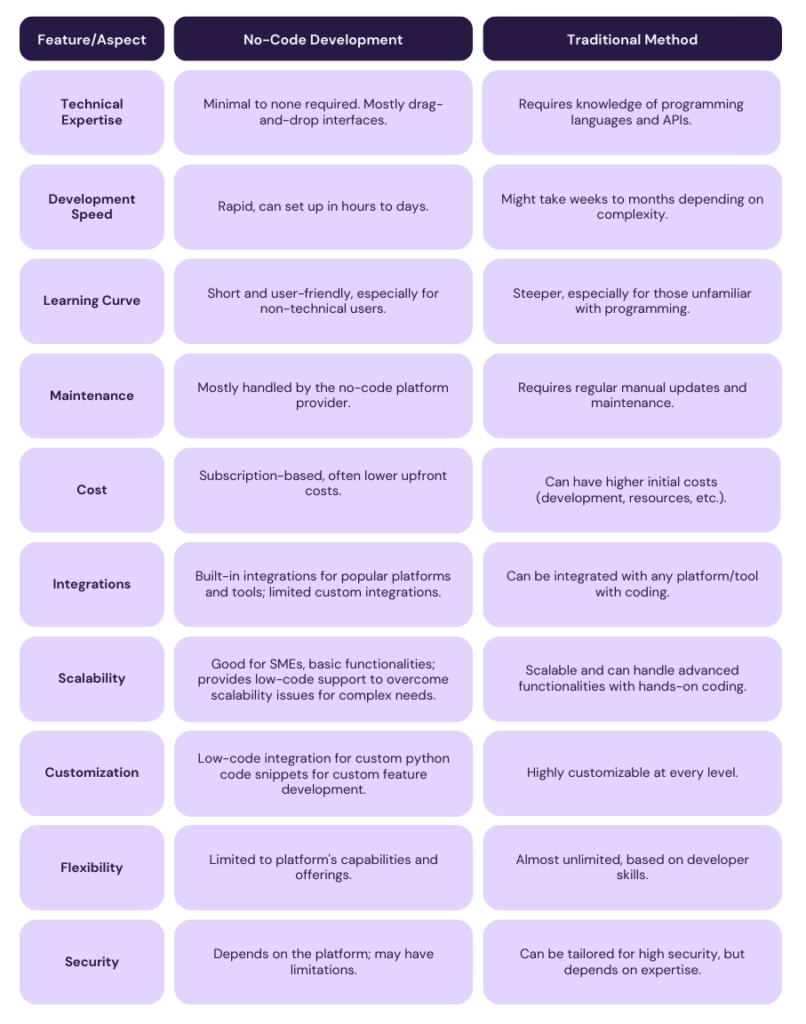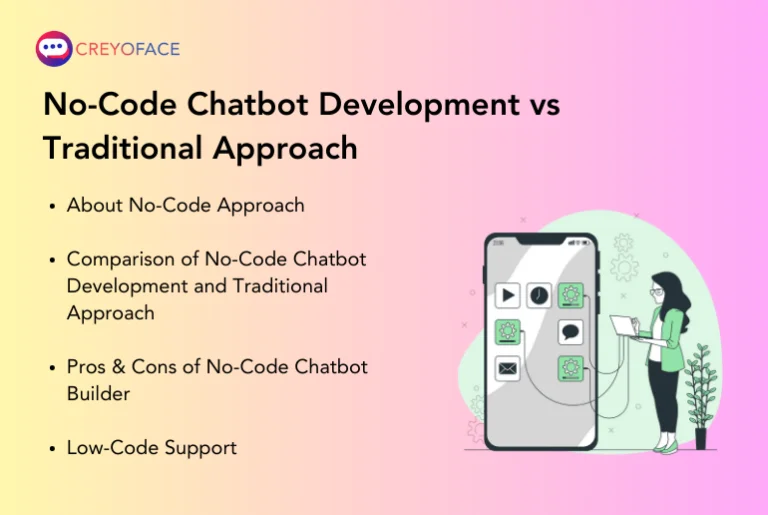Are you an enterprise or a small-scale business? Also, are you considering a no-code or traditional chatbot development approach?
You are in the right place to unclutter your thoughts! This article will help you choose a no-code chatbot development tool to revamp or create a new one.
We are discussing the following aspects to help your conversational AI strategy.
- What is the No-code Development?
- No-Code chatbot development on the rise!
- No-Code vs Traditional chatbot development – A Comparison
- How Low-Code Supports No-code chatbots?
- Pros & cons of the no-code chatbot development tool
- Conclusion
Introduction
What is No-Code? How do No-Code tools drive software development? How is it emerging in AI chatbot development?It is a billion-dollar question now for many enterprises. Digital transformation is changing the way we live our life. Everything is getting transformed. Bookkeeping is happening in spreadsheets! Data centres to cloud storage and physical to digital wallets. Now it enables the development of technology solutions that make our life easy. It paved the way for the emergence of the No-Code approach in building Web-Mobile apps. Furthermore, it is stepping into conversational AI and the advanced analytics scene.
What is the No-Code Development?
By definition, anybody can develop applications with zero coding.
Non-programmer folks can use a visual interface to build applications. It also helps developers to speed up the software development cycle.
So the learning curve is less for non-programmers & tech team can reduce time-to-market. Anyone with business acumen & logical thinking can develop solutions.
How is it making the life of developers or non-developers easy?
User experience is the key here! Users can leverage the drag & drop feature to build program modules with zero coding. Prebuilt templates & layouts specific to industry use cases will be further helpful. There will be a significant reduction in the ideation to launch time.
70% of new enterprise applications will use low-code or no-code technologies by 2025, up from less than 25% in 2020. Gartner
With the available no-code tools in the market, will you bother spending time & money to upsize a tech team? Your competitors might have already started investing in it to reduce the time-to-market.
Below is a survey snapshot from Zapier on industry-wide no-code adoption. The final derivative of this adoption will be excellent customer success & user experience.

No-Code AI Chatbot Development on the Rise!
With the rise of conversational AI, let’s see how it enables the chatbot development space. The following are the main components of the no-code AI chatbot development tool:
- Drag & drop feature to design the conversation flow of a chatbot.
- There is no need to be an NLP engineer to train chatbots for context understanding.
- Add the intents and entities as you add content for web-based CMS.
- Integrate the chatbot with a third-party software ecosystem through built-in & custom connectors.
- Quick integration with downstream applications like social messaging & other enterprise applications. (E.g., WhatsApp, Messenger, website and other enterprise apps, etc.)
- Ready-to-use conversation flow templates that can speed up AI chatbot creation. It will be ideal for business-specific use cases.
No-Code Chatbot Development vs Traditional Approach – A Comparison
Okay! Now, let’s compare the no-code & traditional approach. We can uncover the need for programming expertise, development speed, learning curve and maintenance.

Certainly, the no-code approach is resonating with what the market wants! Certain aspects hold the fort for the no-code approach! – No coding expertise required, high development speed, less learning curve, low maintenance & cost.
But traditional chatbot development gets the upper hand on scalability, customizations, integrations and flexibility. In order to overcome the above concerns, no-code chatbots are evolving rapidly. Subsequently this evolution will ensure high customer success. Summing up, following are some of the areas in which the no-code platforms are investing now:
- User experience – Finding better ways to make chatbot development easy.
- Product support & management – To upkeep a promising product development roadmap.
- Customer experience and feedback collection – To prioritize feature rollouts and backlogs.
- Industry-focused solutions – Targeting specific industry needs and providing ready-to-use prebuilt templates.
Undoubtedly, low-code support in no-code chatbot platforms offers flexibility in chatbot scaling & integrations. So that developers can write custom code to create custom conversational AI features.
How Low-Code Supports No-Code Chatbots?
Although, low-code support for chatbot development will attract the developers to integrate custom functionality. It will power up the chatbots to handle complex operations! E.g., Integration with NLP-powered document AI to extract information.
Team CreyoFace also provides no-code support. It is a boon for many of our clients in the travel tech space to customize specifically for their requirements.
Low-code support enables coders to integrate custom code snippets with the chatbot flow. Additionally, it offers a notebook-like feature to add custom codes with conversational flow. Using low-code support, you can make your chatbot distinct from the competition. Enterprises should consider low code support a must-to-have while selecting a no-code chatbot development tool.
Therefore, it’s now easy to realize the conversational AI strategy for your business. Create a basic flow using the drag & drop feature. Add custom features by leveraging low-code support. Train the chatbot with intents & entities.
Enough of reading? Are you interested in creating a chatbot on your own without coding? Check out the step-by-step guide to creating one using CreyoFace. Sign up for free and create a chatbot!
Let’s Dive Deep into the Pros & Cons of a No-Code Chatbot Builder!

Pros of No-Code Chatbot – Reasons to Consider
Ease to setup & use:
- Anybody with a mind to learn new things can build a chatbot without coding expertise.
- Create a chatbot conversation flow using the drag & drop feature.
- Leverage a prebuilt template specific to your use case to save time & launch your bot quickly.
- Also, training your chatbot is as easy as managing a content management system. Mention the possible user intents, add sample queries and map them to bot responses.
Low initial investment & cost-effective:
- Don’t think about scaling up your team for chatbot development. It may cost a fortune to onboard the entire team. You may need NLP, web front end, back end, and DevOps support.
- The average NLP engineer’s salary itself is $160 K/annum.
- No-Code platforms only have a recurring monthly fee for setting up & creating a chatbot—no substantial initial investment.
Quick scaled cross-channel deployment:
- Businesses can design, develop, test and deploy without a hustle.
- Version control to decide the champion bots with better performance. It will also help to differentiate the testing & live environments.
- Don’t worry about deployment. It is a click away! Whether it is a website or any other downstream platforms.
Easy to integrate with third-party apps:
- The No-Code platform offers a lot of prebuilt integrations.
- It supports major CRM, CMS, Customer support portals, and other industry-leading apps.
- Some tools like CreyoFace offer on-demand API integration with third-party apps.
Easy to update & maintain chatbots:
- When your business and customers are growing, the requirements will also increase. So, you may need a team to maintain the chatbot.
- With a no-code chatbot development tool, business users can manage the changes. They can tweak the conversation flow, customize chatbot training, and increase the deployment channels.
Cons of No-Code Chatbot – Things to Evaluate
Difficult to pick the apt no-code chatbot development tool:
- It will be a tiring process to choose a capable no-code chatbot tool for your business from the handful of options.
- Enterprises should have a clear objective assigned for implementing conversational AI strategy.
- Businesses should monitor pricing, learning curve, product support, and scalability.
Concerns over the integration outside prebuilt ones:
- If your business uses less common software, it requires a chatbot integration. Stop there!
- Check if the no-code chatbot development tool has the integration available. Chances are less.
- Also, check out the customization opportunities. For example, You can pull data but not push back. At times, integrations may have limitations to accessing certain functionalities of downstream apps.
Dependency on the platform:
- Your chatbot’s performance depends on the no-code platform’s feature roadmap.
- No incremental roadmap! If that is the scenario, complex operations based on your business changes may not happen. So it may affect your presence in the competition.
Data security concerns:
- Ensuring the data security of your customer data should be a prime responsibility.
- Customer’s personal information, ID details, and transactional data should be encrypted.
- Many entry-level template-driven chatbot development tools may not have data masking & encryption features.
- A lack of proper data handling and storage security measures can lead to data attacks.
Issues with chatbot uptime:
- No-code chatbot development tools should ensure 24x7x365 chatbot uptime. Customers are likely to be lost if it is down during peak business hours.
- Also, the DevOps side of the no-code chatbot development tool should be strong. Otherwise, a chatbot may not be able to handle the customers effectively. It affects your brand credibility and user experience.
Before deciding to onboard a no-code chatbot development tool for your enterprise, don’t forget to consider the pointers we discussed in the “Cons of no-code chatbot development tool” section.
Having a no-code chatbot development evaluation checklist is a must. It will help you to choose a no-code tool based on your business objectives. Remember to add the above pointers to this list to evaluate the available platforms.
Conclusion
The adoption of conversational AI is flying high. Chatbot builder tools are also evolving faster to cater to enterprise-level needs.
Every enterprise will debate no-code chatbot development vs the traditional approach. No-code chatbot development offers the democratization of conversational AI. It enables your business folks to contribute to making effective chatbots.
Also, it paves the way for Conversational AI workbench and citizen NLP engineers. So, no-code chatbot development platforms are surpassing the efficiency of traditional methods. No-Code is not only about easy to use. It represents a paradigm shift allowing businesses to drive chatbot development faster.
In conclusion, the no-code approach is a boon as businesses focus on agility and efficiency. The critical step is brainstorming the objectives and designing a conversational AI strategy.
Organizations can leverage the best of both worlds by selecting the right platform. They can enjoy the no-code speed with the traditional approach’s flexibility.
Frequently Asked Questions?
What is a no-code chatbot development platform?
It allows any users to design & deploy chatbots without coding.
Users can leverage intuitive, drag-and-drop interfaces or templates to create & deploy chatbots. So it eliminates the need for programming.
How customizable are chatbots created using no-code platforms?
No-Code platforms provide pre-designed templates & functionalities for ease of use. It also offers low-code approach to customize to cater to specific business needs. But, the level of customization varies across platforms.
Are chatbots built on no-code platforms secure?
Security varies across no-code chatbot platforms. Users should choose a platform that focuses on data privacy & security. Your chatbot is handling sensitive customer information. So, it should also comply with regulations & offer data encryption.
Can I integrate third-party tools or APIs with chatbots created on no-code platforms?
Many no-code chatbot platforms support third-party integrations to enhance the bot’s functionality. However, the extent and ease of these integrations can differ, so it’s crucial to check the platform’s capabilities before committing.








